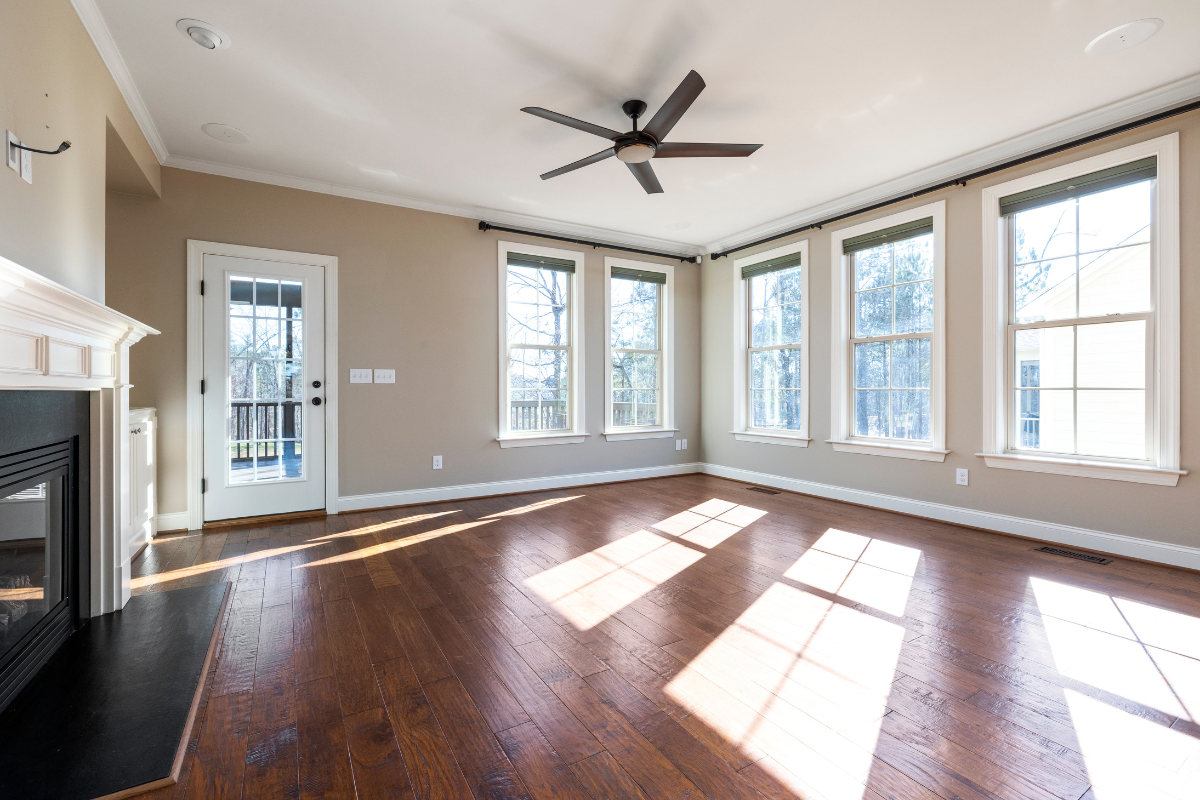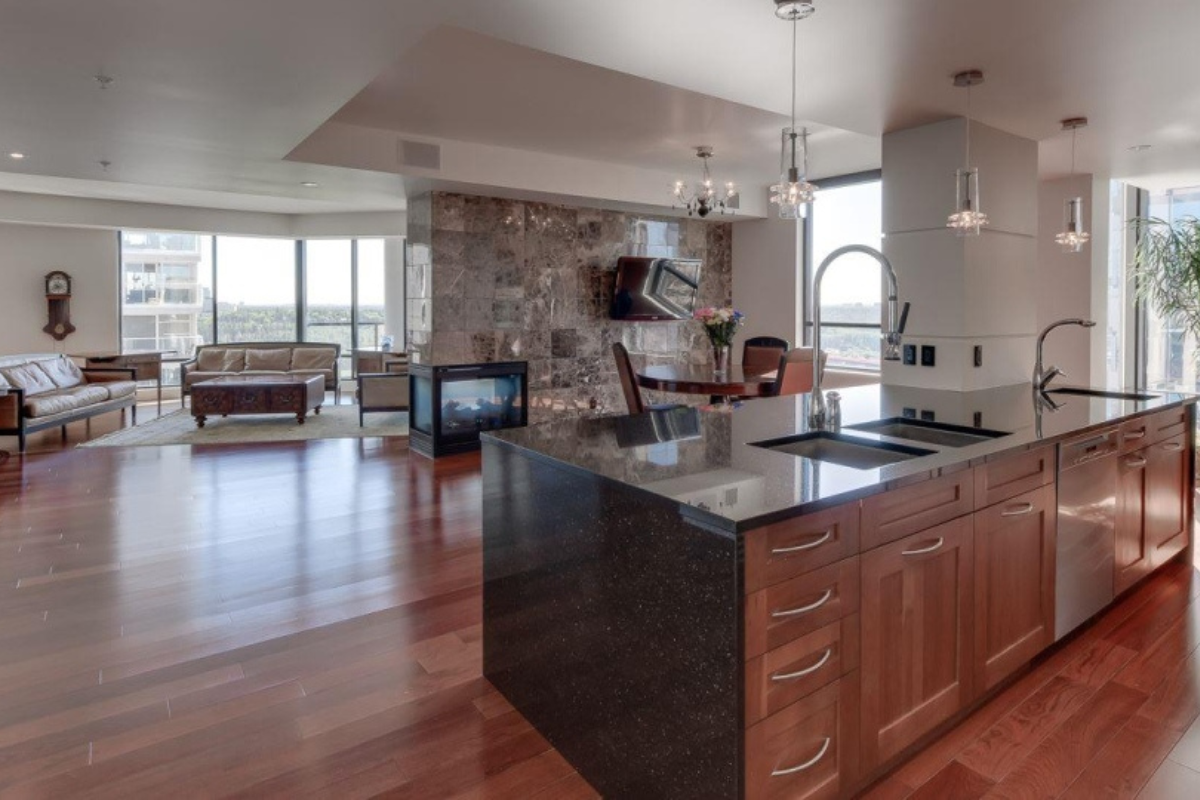Top 10 Tips On How To Hire The Right Flooring Company In Toronto By: Focus…

What Are The Best Alternatives For Real Hardwood Floors?
What Are The Best Alternatives For Real Hardwood Floors?
Hardwood floors exude timeless elegance, but they’re not always the most practical choice for every space.
Fortunately, a myriad of hardwood floor alternatives can offer the same aesthetic appeal with added benefits.
In this guide, we’ll explore the top hardwood alternatives, delve into the best flooring installation practices, and uncover the myriad benefits of renovating your floors.
Let’s get right into it.
Top Hardwood Floor Alternatives and Their Benefits
Engineered Hardwood Flooring
Engineered hardwood combines a real wood veneer with a plywood base, offering a more stable and moisture-resistant option than traditional hardwood. Its layered construction makes it less prone to warping and shrinking.
Luxury Vinyl Plank (LVP)
Luxury vinyl plank flooring mimics the look of hardwood with remarkable realism. It’s durable, water-resistant, and cost-effective, making it an ideal choice for high-traffic areas and spaces susceptible to moisture.
Bamboo Flooring
Bamboo is an eco-friendly alternative known for its rapid growth and sustainability. It’s harder than traditional hardwood, making it resistant to dents and scratches, and it adds a unique, natural charm to any room.
Cork Flooring
Cork is a renewable resource with natural insulation properties. It’s comfortable underfoot, reduces noise, and is resistant to mold and mildew. Cork’s unique texture and appearance contribute to a warm and inviting atmosphere.
Porcelain Tile
Porcelain tile flooring offer the appearance of natural wood but with the durability of tile. They are resistant to moisture, scratches, and stains, making them an excellent choice for kitchens, bathrooms, and other high-moisture areas.
Laminate Flooring
Laminate flooring provides a budget-friendly alternative that replicates the look of hardwood. It’s resistant to scratches, stains, and fading, making it a practical choice for families and pet owners.
Concrete Flooring
For a modern and industrial aesthetic, concrete floors are a versatile option. They can be stained, stamped, or polished to achieve various looks, and they offer exceptional durability.
Ceramic Tile
Ceramic tiles are not only stylish but also resistant to moisture and easy to clean. They come in various patterns and colors, allowing for creative and personalized floor designs.
Carpets and Area Rugs
Soft and comfortable, carpets and area rugs provide warmth and insulation. They come in a wide range of styles, patterns, and textures, allowing for versatile design choices.
Linoleum Flooring
Linoleum is an eco-friendly option made from natural materials like linseed oil and cork. It’s resilient, antimicrobial, and available in a variety of colors and patterns.
Top Flooring Installation Solutions
Professional Installation
Hiring a professional flooring company ensures precise measurements, proper subfloor preparation, and expert installation for optimal results.
DIY Installation
Some flooring options, like click-and-lock systems, are designed for easy DIY installation. However, careful attention to instructions and proper tools is essential.
Floating Floor Installation
Many modern flooring options allow for floating installations, where the planks or tiles interlock without the need for adhesive. This method is quicker and can be less invasive than traditional installations.
Glued-Down Installation
Glued-down installation provides a secure and permanent bond, ideal for high-traffic areas. It’s common with engineered hardwood and some tile options.
Nail-Down Installation
Traditional for solid hardwood, nail-down installation involves securing planks to the subfloor using nails. This method offers stability and longevity.
Loose Lay Installation
Loose lay flooring is not attached to the subfloor, relying on its weight and design to stay in place. It’s a simple and efficient method.
Full Adhesive Installation
In some cases, a full adhesive application is necessary for stability and moisture resistance, especially with certain tile and vinyl installations.
Click-and-Lock Installation
This method involves interlocking the edges of the flooring pieces, creating a seamless and secure connection. It’s a popular choice for DIY projects.
Groutable Tile Installation
For certain tile options, using grout between tiles can enhance the overall aesthetic and create a more authentic appearance.
Subfloor Preparation
Regardless of the installation method, proper subfloor preparation is crucial for a successful and long-lasting flooring installation. Ensure a clean, level, and dry surface.
Top 10 Benefits Of Renovating Floors
Enhanced Aesthetics
Upgrading your flooring instantly transforms the look and feel of your space, creating a fresh and updated aesthetic.
Increased Property Value
Quality flooring is a key selling point for homes. Renovating your floors can contribute to a higher resale value and increased market appeal.
Improved Durability
New flooring materials are often more durable and resistant to wear and tear, providing a longer lifespan for your floors.
Better Comfort and Insulation
Upgrading to materials like carpets, cork, or engineered hardwood can enhance comfort underfoot and improve insulation, making your space cozier.
Health and Safety
Removing old, worn-out flooring eliminates potential health hazards like mold or allergens, contributing to a healthier indoor environment.
Ease of Maintenance
Many modern flooring options are designed for easy maintenance, saving you time and effort in cleaning and upkeep.
Energy Efficiency
Certain flooring materials, like cork and carpet, offer natural insulation properties, contributing to improved energy efficiency in your home.
Adaptability to Lifestyle Changes
Updating your flooring allows you to adapt your space to changes in lifestyle, such as accommodating a growing family or evolving design preferences.
Increased Light Reflection
Light-colored flooring options can reflect more natural light, brightening up your space and creating a more inviting atmosphere.
Personalized Style
Renovating your floors provides an opportunity to express your personal style. With a wide range of options, you can choose flooring that aligns with your taste and complements your decor.
Top 10 FAQs and Answers About Flooring Installation
Q: Can I install flooring over existing flooring?
A: In many cases, yes. However, it depends on the type of flooring and its condition. Consult the manufacturer’s guidelines for compatibility.
Q: How long does flooring installation typically take?
A: The timeframe varies depending on the type of flooring and the size of the project. Professional installations may take a few days, while some DIY-friendly options can be completed in a weekend.
Q: What is the best flooring for high-traffic areas?
A: Durable options like luxury vinyl plank (LVP), porcelain tile, and laminate are suitable for high-traffic areas due to their resistance to scratches and wear.
Q: Can I install new flooring over a concrete subfloor?
A: Yes, many flooring options are compatible with concrete subfloors. Proper moisture testing and preparation are essential.
Q: Do I need underlayment for my flooring installation?
A: It depends on the type of flooring. Some materials, like laminate and engineered hardwood, benefit from underlayment for added insulation and sound absorption.
Q: How do I maintain and clean my new floors?
A: Maintenance varies by flooring type. Generally, regular sweeping, vacuuming, and damp mopping are suitable. Follow the manufacturer’s recommendations for specific care instructions.
Q: Can I install flooring in a bathroom or kitchen?
A: Yes, but not all flooring materials are suitable for moisture-prone areas. Choose water-resistant options like porcelain tile, luxury vinyl, or ceramic tile for these spaces.
Q: What is the difference between solid and engineered hardwood?
A: Solid hardwood is made from a single piece of wood, while engineered hardwood consists of a veneer layer on top of a plywood base. Engineered hardwood is more stable in varying moisture conditions.
Q: Can I install flooring myself, or do I need a professional?
A: Many flooring options are DIY-friendly, especially those with click-and-lock or floating installation systems. However, for certain materials or intricate designs, professional installation is recommended.
Q: How do I choose the right flooring for my space?
A: Consider factors such as the room’s function, foot traffic, moisture levels, and your design preferences. Consult with flooring experts and review samples to make an informed decision.
Conclusion
Renovating your floors is a transformative journey that goes beyond aesthetics.
From exploring hardwood floor alternatives to mastering the art of flooring installation, this guide has provided a comprehensive overview of the options available.
Whether you seek durability, sustainability, or a touch of luxury, the diverse range of flooring materials ensures there’s a perfect fit for every space. Embrace the benefits of a flooring upgrade, and let your home reflect your style and functionality with a renewed foundation.
If you have any questions about our article, “What Are The Best Alternatives For Real Hardwood Floors?” or need flooring installation, feel free to contact us on social media or at (647) 945-8780 for more information.



